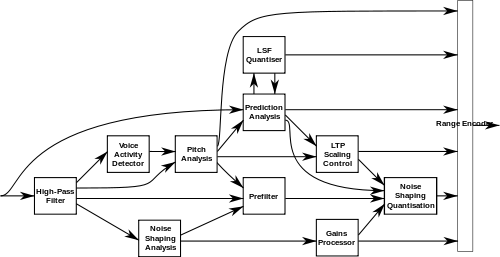SILK
| Developer(s) | Skype Limited, Microsoft |
|---|---|
| Initial release | 2009 |
| Stable release | 1.0.9
/ 2012 |
| Written in | C, C++ |
| Operating system | Microsoft Windows, macOS, Linux, Android, iOS |
| Type | Audio codec |
| License | BSD 2-Clause License[1] |
| Website | developer |
| Filename extension |
.sil, .SIL |
|---|---|
| Internet media type |
audio/SILK |
| Magic number | #!SILK\n |
| Initial release | March 2009 |
| Latest release | SDK 1.0.9 2012 |
| Type of format | Audio |
| Extended to | Opus |
| Standard | Internet Draft |
SILK is an audio compression format and audio codec developed by Skype Limited, now a Microsoft subsidiary. It was developed for use in Skype, as a replacement for the SVOPC codec. Since licensing out, it has also been used by others. It has been extended to the Internet standard Opus codec.
Details

Skype Limited announced that SILK can use a sampling frequency of 8, 12, 16 or 24 kHz and a bit rate from 6 to 40 kbit/s. It can also use a low algorithmic delay of 25 ms (20 ms frame size + 5 ms look-ahead).[2] The reference implementation is written in the C programming language. The codec technology is based on linear predictive coding (LPC).[3] The SILK binary SDK is available.[4]
License
The SILK codec is patented and licensed separately from the SILK SDK.[5] The codec is open-source, freeware, available royalty free with restrictions on use and distribution.[4][6][7] The SDK was initially available only by application by giving details of name, address, phone, and description of how SILK will be used.[4] As of 2012[update] (version 1.0.9) the SDK can by downloaded without application, but the licence restricts the use to internal evaluation and testing purposes only, excluding software distribution or use in any commercial product or service.[4][8]
History
SILK replaces the previously used SVOPC in Skype, which was a in-house solution to replace the iSAC and iLBC, which again were licensed from Global IP Solutions. The SILK codec was a separate development branch from SVOPC and it has been under development for over 3 years.[9] It was announced in January 2009 on the Consumer Electronics Show[9] and was integrated in Skype for the first time in version 4.0 beta 3 from January 7, 2009,[10] with the final version being released on February 3.[11] On March 3, 2009 Skype Limited announced that the SILK codec will be available soon under a royalty free license to third-party software and hardware developers.[6] The first draft of the SILK Speech Codec description was submitted to the Internet Engineering Task Force (IETF) as a candidate for the standardisation of a new Internet wideband audio codec on July 6, 2009, thereby openly publishing the format along with the source code of the reference implementation.[12] There is also a first draft of the RTP Payload Format and File Storage Format for SILK Speech and Audio Codec.[13]
Opus
SILK is a foundation (with CELT) of the hybrid codec Opus (at the time called "Harmony") that was submitted to the IETF in September 2010,[14] and was chosen as the final candidate for the new standard. Opus was published as an IETF proposed standard in September 2012.[15]
Usage
- The stable version of SILK was first introduced in Skype 4.0 Beta 3 for Windows, released on January 7, 2009.[10]
- The final version of Skype 4.0 was released on February 3, 2009.[16][17]
- On March 22, 2011 the Steam game platform started using the SILK codec for its integrated in-game and community voice chat.
- Later in 14 April, in Team Fortress 2, the codec was implemented into the in-game voice chat.[18]
- On January 29, 2013 the updated to SteamPipe platform Gold Source started using the SILK codec for the in-game voice chat.
- It has been found being used on Zoom.[19]
See also
References
- ^ https://github.com/ploverlake/silk
- ^ Skype SILK Data Sheet, Retrieved 2009-09-01
- ^ Audio-Mitschnitt Archived 2013-02-10 at the Wayback Machine vom Treffen der IETF-Codec-Arbeitsgruppe auf der Konferenz IETF79 in Peking, China mit einer Darstellung der grundlegenden Funktionsprinzipien durch Koen Vos (MP3, ~70 MiB)
- ^ a b c d Skype SILK – Super Wideband Audio Codec, Retrieved 2009-09-01
- ^ SILK Patent License, Retrieved 2012-12-26
- ^ a b Jonathan Christensen (2009-03-03) SILK, our super wideband audio codec, is now available for free Archived 2009-12-23 at the Wayback Machine, Retrieved 2009-09-01
- ^ Skype publishes SILK audio codec source code, Retrieved 2012-12-26
- ^ Skype Developer Forum - SILK SDK license Archived 2012-08-03 at the Wayback Machine, Retrieved 2012-12-26
- ^ a b Michael Stanford (2009-01-13) Skype’s new super-wideband codec, Retrieved 2009-09-01
- ^ a b Skype Journal (2009-01-07)Skype for Windows 4.0 Beta 3 Hotfix Introduces New Audio Codec, Retrieved 2009-09-01
- ^ http://about.skype.com/2009/02/allnew_skype_now_available.html
- ^ IETF (2009-07-06) SILK Speech Codec - draft-vos-silk-00.txt, Retrieved 2009-09-01
- ^ IETF (2009-07-06) RTP Payload Format and File Storage Format for SILK Speech and Audio Codec, Retrieved 2009-09-01
- ^ Definition of the Harmony Audio Codec
- ^ Jean-Marc Valin, Koen Vos; Timothy B. Terriberry (September 2012). "Definition of the Opus Audio Codec". RFC 6716. IETF. Retrieved 2013-08-19.
{{cite web}}: Unknown parameter|lastauthoramp=ignored (|name-list-style=suggested) (help) - ^ PCWorld (2009-02-04)Skype Upgrade Simplifies VoIP Video Calls, Retrieved 2009-09-01
- ^ (2009-02-04) Skype 4.0 audio: smooth as SILK, Retrieved 2009-09-01
- ^ http://www.teamfortress.com/hatless/
- ^ https://citizenlab.ca/2020/04/move-fast-roll-your-own-crypto-a-quick-look-at-the-confidentiality-of-zoom-meetings/
External links
- SILK – Super Wideband Audio Codec at the Wayback Machine (archived July 24, 2013)
- Koen Vos; Karsten Vandborg Sørensen; Søren Skak Jensen; Jean-Marc Valin (2013-08-02), "The Opus Codec – Voice Coding with Opus" (PDF), AES Convention 135, Microsoft, GN Netcom A/S, Mozilla Corporation
- silk on GitHub
